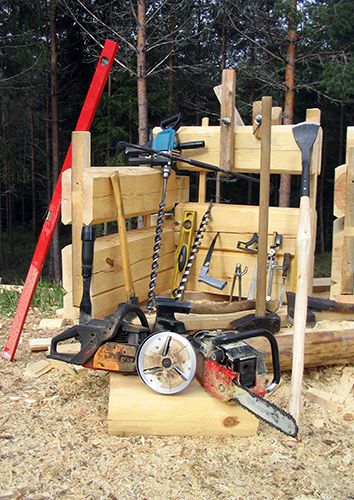The traditional log hewing tools used in Finland have been simple and of high quality. Traditional saws, such as a cross-cut saw and a joiner’s saw, have been replaced and supplemented by power tools and chainsaws.

However, trees are still debarked by means of bark spuds and peeling irons, and the types of axes used for cutting have also remained almost unchanged.
The augers used for the tenons of log walls have changed significantly over time. Traditional augers have been replaced by augers equipped with tip threads and cutting bits.
The logs can be matched precisely to each other by using a marking tool called scriber. A single-sided scriber has only been used for marking the longitudinal groove in logs. In a two-sided scriber, the spikes on one side can also be used to define the notches in the corners.
Before modern spirit levels, the horizontal position of the logs was determined using a piece of board and plumb line.
The logs are fastened in place during the various work stages by using holding hooks. There have always been at least two sizes of holding hooks.
A pair of compasses is used for measuring the corner joints. Especially in a rough initial fitting, there is a need for larger dimensions that what a scriber could provide. An adjustable angle measuring tool is required for making short corners.
A knife is still a basic tool for every carpenter and joiner. A log builder’s knife set is often a combination of two or three knives, also containing, for example, a small knife and a pen.
Chisels are essential tools in the finishing of corners. One chisel should be curved and the other straight. A gouge axe is also traditionally used for finishing the bases of longitudinal joints.
A modern log building site also contains power tools such as milling machines, planers, saws and hewing discs. A chainsaw is also an accurate and efficient tool in skilled hands.